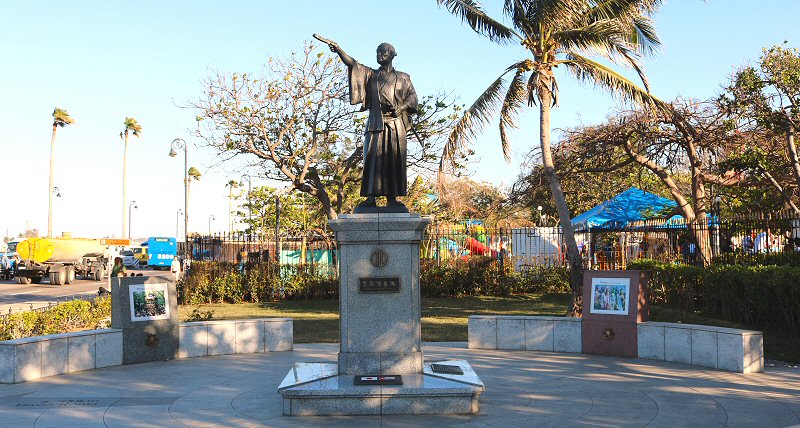
The monument of Hasekura Rokuemon
Tsunenaga is located on the Malecón (Avenue del Puerto), in
front of the the Céspedes park.
Hasekura Rokuemon Tsunenaga (baptized as Francisco Felipe Faxicura in Spain) (1571–1622) was a veteran Japanese samurai and retainer of Date Masamune (founder of the city Sendai, a statesman of great political vision, considered among the most skilled warriors of the time). He was the hero of Sendai and pioneer in Japanese history, who strived for internationalization.
Hasekura Rokuemon Tsunenaga is best
known by the diplomatic mission that he has undertaken from
1613 to 1620 to open new doors in Europe for the commercial
future of Japan. His objective was to persuade Vatican to
send Christian missionaries to Japan, and thus to persuade
the superpower Spain to make trade agreements with his
country. The route to Spain was passing
through the New World, so that he arrived in Acapulco,
Mexico, and departed from Veracruz, Mexico. Before arriving
in Spain, he stopped on his ship San Juan Bautista at Havana
in 1614, thus he became the first Japanese known that had
set foot on the Cuban soil. He stayed 6 days in Havana and
changed the ships. He is considered also the first Japanese
ambassador in the Americas, as well as in Spain. He followed
the route by land through Seville, Madrid, and Barcelona,
and visited ports of call in the Mediterranean Sea, like St.
Tropez where he met with the French authorities. It was the
first contact between France and Japan. Travelling along the
Italian coast, he arrived in Rome where he met with Pope
Paul V that agreed to send missionaries, however, left the
decision for commercial exchange to the King of Spain. Even
though the Japanese delegation was cordially hosted in
Spain, it was the time when the Christianity was under
oppression in Japan, so that Philip III, King of Spain,
refused to seal the trade agreements with Japan. With a few
success, Hasekura Rokuemon Tsunenaga returned to Japan,
following the same route, but also visiting Manila. Japan
that adopted an isolationist policy, assigned the next
embassy to Europe after more than 200 years, in 1862.
Many years had to pass that Cuba
would be again the home for some Japanese. Some dekadegui
(the name given to the Japanese that emigrated and live
scattered around the world) that had left for North America,
arrived in Cuba in small groups from 1898 to 1943. In the
period of 1924-1926 the largest wave of immigration of
Japanese occurred in the history of Cuba, as a travel
company, called Oversea, was facilitating the transit to the
island. The Japanese did not stay limited in a certain area,
but they settled throughout the island. They worked in
different fields of business life, but above all in
productive sectors such as agriculture, mines, sugar
industry, fishing, agriculture, mechanics, electricity and
services. It is estimated that currently about 250 Japanese
are residing in Cuba.
The monument was established with
the cooperation of the Japanese Sendai Ikuei Gakuen High
School that was founded by Rikichi Katoh in Sendai, Japan in
1905, and the bronze statue of Hasekura Rokuemon Tsunenaga
was erected on a granite platform, as a symbol of fraternity
and perpetual peace between Cuba and Japan. Some stones
brought from the Castle of Sendai are placed in the area of
the monument. The statue is the work of the Japanese artist
Mizuho Tsuchiya and the monument was in augurated in 2001.
The sculpture represents Tsunenaga,
dressed typical of a medieval Japanese samurai, with a long,
slightly curved Samurai sword katana. With his outstretched
arm he holds a traditional fan, pointing at the direction of
Sendai.

